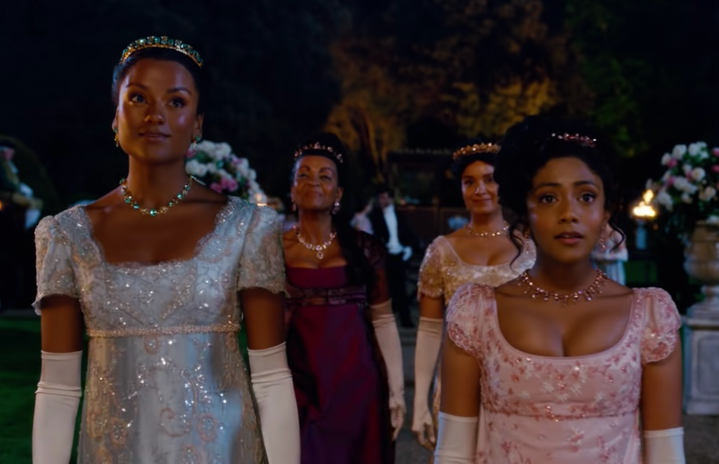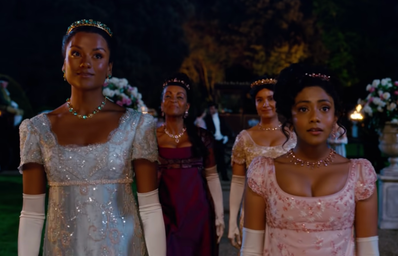On March 25, season two of Netflix’s hit romance television series Bridgerton premiered, and fans everywhere glued their eyes to their screens to watch the plot of yet another steamy period drama unfold (who else was obsessed with Downton Abbey?). But what makes Shonda Rhimes’ Bridgerton different from other period dramas is her goal of thoughtfully integrating diversity into the show. In an interview in March, Rhimes commented on how a global audience makes inclusion so important. “That audience is the world, literally. I wanted to make sure that if you are watching ‘Bridgerton’ from another country, you’re not thinking to yourself, ‘Well, this has nothing to do with me,’” Rhimes said. “Well, absolutely it has something to do with you. The humanity in every character should feel universal.”
This season, two South Asian women, Simone Ashley and Charitha Chandran, were cast as the two female leads, Kate and Edwina Sharma, demonstrating the positive impact that Bridgerton‘s representation of South Asian women has in media and television.
Similar to last season, this season of Bridgerton centers around the year’s courting season. However, instead of the character of interest being Daphne, the focus now falls on her older brother, Viscount Anthony Bridgerton. Kate and Edwina, along with their mother Mary, traveled from India for Edwina to participate in this year’s courting season. When looking for a bride, Anthony and Edwina’s paths cross and he finds her to be a “perfect match.” However, Kate, as the protective older sister, disapproves of the match due to her distaste for Anthony’s character.
In the book series of Bridgerton, Kate and Edwina are portrayed as white women, yet the creators and writers decided to follow the same diverse casting principles as season one. However, it’s not exactly color-blind casting, as Kate and Edwina’s ethnicity does play a part in their identity. In the show, the Sharma sisters are clearly identified as Indian women who use Indian terminology and even have a slight Indian accent. Edwina, for example, calls Kate “didi,” a term many Hindi-speakers use to refer to their older sisters.
In the show, Kate and Edwina’s cultural behaviors, terms, and differences are never pointedly ridiculed or questioned by the white characters. Bridgerton never attempts to make race and culture a plot point or a point of conflict, and while that may be historically inaccurate, it gives the show space to integrate diversity without tokenism. This graceful integration of South Asian culture is not only rare for Regency era dramas, but also for television and Hollywood as a whole. Historically, Western media is notorious for either excluding South Asians from films and shows or crudely portraying them with age old stereotypes.
Kate and Edwina give us representation that isn’t attached to a negative trope or tokenization. Their Indian identities are neither ignored or negatively sensationalized. They aren’t talked about as being suitable for Anthony despite being Indian or despite not being white. They are simply two beautiful Indian women who are presented as such, and their costumes and hair are never inferior to the other white female characters on the show.
Beyond physical appearance, Kate and Edwina are also presented to be just as educated and integrated into high society as the other white characters. In the show, Edwina and Kate are familiar with high society etiquette as well as all proper ballroom dances. They are also written to be extremely educated and well-spoken. In several scenes, Edwina mentions her love for reading and literature, while Kate expresses an interest in being a governess, which is the equivalent of a teacher in the Regency era.
In an interview with Character Media, Chandran, who plays Edwina, explains the depth of ethnic representation in the show. “What’s really special is that [Kate and Edwina] don’t just happen to be brown, but they are Indians that are immigrants in London and that’s not just simply an extra factor in their identity but it really informs the characters. It’s an incredible and thoughtful representation,” said Chandran.
The critique with a lot of South Asian representation is that they see their identity as an obstacle. Bend it Like Beckham was one of my favorite films growing up, but the plot is set up in a way where the main character Jess has to overcome the expectations tied with her Indian identity to play soccer. In Never Have I Ever, Devi sees her Indian identity as something that’s holding her back from being desirable to her peers in school, especially her male peers.
The effects of this incredible representation shows, with South Asian creators on TikTok and Twitter showing their appreciation. “Anyone else’s heart feel utterly warm after seeing the Indian references weaved into #Bridgerton S2? From the use of ‘Didi’, haldi scenes, hair oiling, darker-skin South Asian representation, Kate hating English tea and the Sharma sisters being the beauts of the season!” says Twitter user @BritishBindi.
What makes Bridgerton especially prevalent is that the creators and writers chose to cast actresses with darker complexions to play lead roles. This is not only a breakthrough for Hollywood, but for film as a whole. Bollywood is reluctant to cast women who are darker because of the colorist beauty standards present in India. Indian feminine beauty generally tends to be defined by soft feminine features and a light complexion.
In a CNN article from 2020, sociologist Sanjay Srivastava, who works for the Institute of Economic Growth in Delhi, says that these beauty standards are linked to the caste system. “Hindu religious texts are full of what we would now recognize as racial stereotypes: lower caste figures as dark and ugly… To be dark is to be a manual laborer, working in the sun. Fair skin is also a mark of class,” said Srivastava. He also notes British colonialism as another reason for colorism in India, stating that as more Anglo-Indians (mixed race individuals with one British parent and one Indian parent) were born, the proximity to whiteness seemed more prestigious and desirable.
With Bridgerton, these prejudices and predispositions about casting darker-skinned actresses are set aside, and rightfully so. South Asian women are and have always been beautiful physically and culturally, and a hit television show deciding to showcase that is marvelously important.
Casting Ashley and Chandran as Kate and Edwina will allow other South Asian young women from all over the world to see women like themselves in a space where they are appreciated for their ethnic features and rich cultural background. That is something that South Asia girls have been deprived of for many decades in western media, and now that reality has finally been broken.


